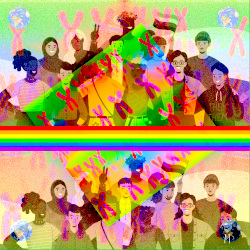It's time to recognise the third gender, by Shokti
 15 countries around the world legally recognise a third, non-binary gender. Unfortunately the UK did not become the 16th this week.
15 countries around the world legally recognise a third, non-binary gender. Unfortunately the UK did not become the 16th this week.
'Trans Women are Not Women' scream the right wing press headlines, ignoring the fact that the UK Supreme Court did not rule on this question. The Court was clarifying whether references to sex in the Equality Act of 2010 referred to biological sex.
In fact paragraph 2 of the judgment clearly states: “It is not the role of the court to adjudicate on the arguments in the public domain on the meaning of gender or sex, nor is it to define the meaning of the word ‘woman’ other than when it is used in the provisions of the [Equality Act] 2010.” Yet the right wing press is having a field day, pictures of women celebrating outside court accompanying the headline. This is very revealing, and I hope it will strike home hard to the gay, lesbian, bi community how important it is we stand together with trans people against a tide of populist propaganda, fear-mongering and ignorance.
'By elevating “biological sex” as the singular legal definition of womanhood, the court sanctifies a worldview rejected by decades of medical, sociological, and psychological evidence. Gender is not chromosomes. It is not genitals. It is not a passport stamp from birth. But the ruling chooses dogma over data, ideology over science, regression over rights — and does so knowing whose lives will pay the cost.' UK Supreme Court Rules Against Trans Rights and Hands Fascism a Blueprint – Trans Army
Biology actually teaches us that everybody has both testosterone and oestrogen hormones in our bodies, physically and psychologically we are all a mix of 'masculine' and 'feminine' features. Chromosomes are more complex that simple X and Y, and - on that point - every foetus starts out with an X – everyone is female at the core. The long domination of men over women, and of masculine men over feminine men and trans people, has to come to an end. Surely this is what feminism has always sought? The feminine aspect of the life is surging forward – rising strongly in some men, and in my opinion in also in AFAB people who become trans men: I see the Goddess in us all as pushing us to manifest BALANCE, not to replace male dominance with her own.
Spirituality points us in the same direction – teachings from around the world point to the marriage of the inner genders, uniting and transcending them to unify the Self, as the way to reach spiritual consciousness. Jesus is quoted saying this in the Gnostic Gospel of Thomas, in Hindu culture Shiva Ardhanishvara depicts the divine as a balance of male and female. In Indian culture, alongside so many others around the world, people born with a gender-fluid nature, who embodied both male and female traits, have long been regarded as natural and been associated with spiritual roles.
- The Hijra of India
- The Mahu of Polynesia
- Fa’afafines and Fa’afatamas in Samoa
- Warias of Indonesia
The Bugis people of Indonesia recognize five genders: oroane (manly men), makkunrai (womanly women), calabai (womanly men), calalai (manly women), and bissu (half-male and half-female).
"In Nepal, the term ‘third gender’ has been used, which is derived from the root word Tritiya Prakriti (‘person of third nature’ in Sanskrit language). There were more than two genders recognised in East and South Asia, and most of African and other indigenous societies until Christianity or Islam took over. Gender variant people have existed throughout the world and across time, celebrated in some cultures, denigrated in others." Binary Compulsion: A dangerous gender myth, by Sunil Pant
Muxes in Mexico. Two Spirits of Native America
Sekrata in Madagascar: “The Sakalava people of Madagascar understand that having a third-gender child is natural. Sekratas usually avoid male associated roles like joining the army, often performing as dancers in tribal ceremonies. Moreover, they are believed to be sacred and have magical powers and they may be feared by people who follow the tradition associated with their existence.” Cultures With Multiple Genders: 5 Vibrant Traditions Worldwide
In early seventeenth-century Luanda (the capital of Portuguese Angola), Catholic priests Gaspar Azevereduc and Antonius Sequerius documented third-gender natives known as chibados. The chibados dressed like women, spoke effeminately and married other men. Most shocking to the priests was the fact that such marriages were honoured and even prized among the tribesmen. In a similar record, Portuguese Jesuit Joao dos Santos wrote in 1625 that the chibados of south-western Africa were “attyred like women, and behave themselves womanly, ashamed to be called men; are also married to men, and esteeme that unnaturale damnation an honor.”
In 1957, American anthropologist Simon Messing found male transvestites among the Amhara tribes of Ethiopia that were known as wandarwarad (male-female). They lived alone and were considered like brothers to the tribeswomen. The husbands of the women were not at all jealous of the close friendship between their wives and the wandarwarad. Messing reported that the wandarwarad were unusually sensitive and intense in their personal likings. He also found “mannish women” among the Amhara known as wandawande.”
“Inscribed pottery shards discovered near ancient Thebes (now Luxor, Egypt), and dating from the Middle Kingdom (2000-1800 BCE), contain a listing of three genders of humanity: males, eunuchs, and females, in that order. The word for male includes a picture of a penis and a picture of a man kneeling. The word for eunuch includes a picture of a man kneeling, but not a picture of a penis. The word for female includes a picture of a woman kneeling, but no picture of body parts (unless the shield-like shape which designates "woman" is a picture of the female pubic region).” From Mark Brustman's Born Eunuchs website
In ancient times Judaism recognized six genders: zachar, nekeivah, androgynos, ay’lonit, saris, and tumtum. A zachar is male, a female, and an androgynos is half-male, half-female. An ay’lonit is a female who becomes male at puberty, a saris is a male who becomes a female at puberty, and a tumtum has an indeterminate gender.
Pre-Christian European cultures also recognised a diverse, gender-fluid reality. Ancient Goddesses were depicted with penises, gender-bending Dionysus was possibly the most popular god for many centuries. Goddesses since the time of Ishtar in Sumeria had been served by gender-variant priests. The Gallae priests of the Goddess Cybele, the Magna Mater of the Rome for 600 years (with roots going back millennia in the lands of modern Turkey), were akin to the Hijra and similar priestess groups. The priests were castrated, wore feminine clothes and make up, and led ecstatic, sometimes bloody, rituals. Christian writers complained about their womanish ways constantly. St Augustine railed against self-castrated priests: “here a man is so mutilated that he is neither changed into a woman nor remains a man.” Isis, Artemis, Atargatis, Venus – all goddesses were served by gender-bending 'queer' priesthoods alongside their female priestesses. Yes the Gays in ancient times served Gaia.
2nd century Greek philosopher Sextus Empiricus wrote that: "The Mother of the Gods also admits effeminates, and the Goddess would not judge so, if by nature unmanliness were a trivial thing.”
Eunuchs were not confined to the temples. They would have been common enough in society and often served in courts and administrations, as well as harems in many cultures. 1st century Roman author Pliny in his work Natural Histories referred to hermaphrodites and eunuchs as “a third class of half men.” The ancient world distinguished between man-made and 'natural' eunuchs – with the latter referring to men who were not attracted to women. Jesus is quoted in Matthew's Gospel as saying there are 3 kinds of eunuchs – those born that way coming first on his list, followed by those who are made eunuchs by others and those who chose to become eunuchs 'for the sake of the kingdom of heaven'. Here he was likely referring to the castrated priests of the Goddess temples, but the quotation influenced early Christians and the Church had to ban castration among its priests.
In the Historia Augusta, a late Roman collection of imperial biographies, Emperor Severus Alexander (reigned 208-235 directly after Rome's third-gender Emperor Elagabalus) is quoted as calling eunuchs a 'tertium genus hominum' – the third kind of people, but by the 4th century Christian convert Firmicus Maximus was referring to them as men “without seed and who cannot copulate, obscene, disreputable, filthy, lewd passives." The idea of a third gender was pushed out of the Christian conversation, and the imposition of a binary model into which everyone was expected to fit began.
Yet throughout the Christian centuries men who felt more like women have of course appeared to disrupt the social norms – famously for example in 18th century English 'molly' culture.
Same sex love and gender-fluidity are natural human qualities that have been suppressed for centuries in white cultures due to Christian beliefs. The repeal of legal punishments and the gradual increase in social acceptance in recent decades in the western world has made possible the re-emergence of these traits, of these characteristics. The suppression has been so deep that the change is coming up in a rush and upsetting the binary model that is declared to be the bedrock of our 'culture'.
🏳️🌈 Let's take this opportunity to turn the spotlight on the presence of third-gender people in other cultures around the world and to discover the true history of our own.
And also to take the steps to explore and reclaim the spiritual inheritance that the tales of our ancestors are telling us about...




